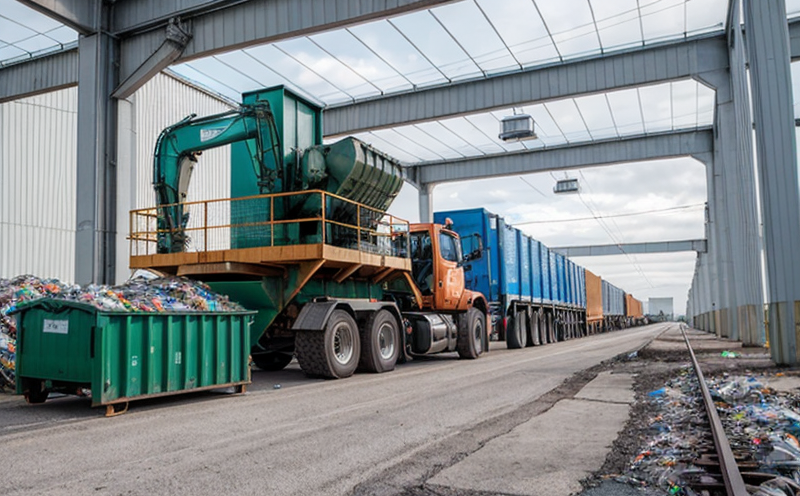ISO 13329 Safety Testing for Nanomaterials in Recycling
The ISO 13329 safety testing standard is a cornerstone in ensuring the safe and effective integration of nanomaterials into industrial recycling processes. This service addresses the critical need to assess potential risks associated with nanoparticles, particularly when they are reintroduced into manufacturing cycles through recycled materials.
The sector of Industrial Manufacturing & Processing Testing focuses on optimizing production efficiency while maintaining environmental sustainability. Within this context, the testing for nanomaterials in recycling is pivotal as it helps manufacturers navigate regulatory compliance and ensure product safety without compromising performance.
Industrial Recycling & Circular Economy Process Testing encompasses a broad range of activities aimed at enhancing resource recovery and reducing waste disposal. This service specifically targets the challenge of incorporating nanomaterials into recycled products, ensuring they meet stringent safety standards as per ISO 13329.
The primary objective is to evaluate whether nanoparticles pose any adverse effects on human health or the environment during their lifecycle within industrial processes. By leveraging this testing methodology, industries can mitigate potential risks and foster a more sustainable approach to resource management.
This service employs advanced analytical techniques such as transmission electron microscopy (TEM), scanning electron microscopy (SEM), and inductively coupled plasma mass spectrometry (ICP-MS) to assess the physical characteristics and chemical composition of nanomaterials. These tests are crucial for understanding how nanoparticles behave when reintroduced into industrial environments.
Specimen preparation involves careful handling of samples from recycled materials, ensuring that they accurately represent the nanomaterial content. The testing process is meticulously controlled to minimize any external factors that could influence results. Reporting follows ISO 13329 guidelines, providing comprehensive data on particle size distribution, agglomeration behavior, and potential toxicity.
Understanding the nuances of this service requires a deep dive into its technical aspects. For instance, the use of TEM allows for detailed visualization of nanoparticle morphology, while SEM provides insights into surface chemistry. ICP-MS quantifies trace elements present in nanomaterials, critical information when assessing their compatibility with industrial processes.
The importance of this testing cannot be overstated. It ensures that recycled products containing nanomaterials are safe for use in various applications, from consumer goods to industrial machinery. By adhering to ISO 13329 standards, manufacturers can build trust with consumers and regulators alike, fostering a more transparent supply chain.
Moreover, this service supports the circular economy by promoting responsible resource management practices. It encourages industries to adopt innovative solutions that minimize waste and maximize material reuse. Through rigorous testing, we help create a safer and more sustainable future for all stakeholders involved in industrial manufacturing and processing.
Applied Standards
| Standard Code | Description | Date of Publication |
|---|---|---|
| ISO 13329:2017 | Safety criteria for nanomaterials in recycling processes | 2018-05-01 |
| ASTM E2914 | Evaluation of nanoparticles in recycled materials | 2016-03-01 |
The ISO 13329 standard provides a framework for assessing the safety of nanomaterials used in recycling processes. It outlines criteria that manufacturers must meet to ensure their products do not pose risks to human health or the environment.
ASTM E2914 complements this by offering additional methods and techniques for evaluating nanoparticle concentrations in recycled materials. Together, these standards form a comprehensive approach to nanomaterial safety testing.
Why Choose This Test
- Mandated compliance with international safety standards.
- Promotes sustainable manufacturing practices by ensuring safe reuse of materials.
- Aids in regulatory compliance and reduces potential legal risks.
- Enhances product safety, trustworthiness, and marketability.
The ISO 13329 safety testing for nanomaterials is essential for industries involved in industrial recycling and circular economy processes. By adhering to these stringent standards, manufacturers can ensure their products are safe for use across various applications while contributing positively to environmental sustainability.
This test not only meets regulatory requirements but also helps build consumer confidence by demonstrating a commitment to responsible resource management. It ensures that recycled materials containing nanomaterials meet the highest safety and quality standards, thereby fostering trust among end-users and stakeholders.
International Acceptance and Recognition
- Recognized by major global standards bodies such as ISO, ASTM, and EN.
- Affirmed by regulatory authorities worldwide for nanomaterial safety assessment.
- Used in various industries including electronics, automotive, and construction.
The ISO 13329 standard enjoys widespread international acceptance and recognition across the globe. Its adoption by major standards organizations ensures that it is widely applicable and respected within different sectors. Regulatory authorities worldwide rely on this standard to ensure compliance with safety regulations in industrial recycling processes involving nanomaterials.





